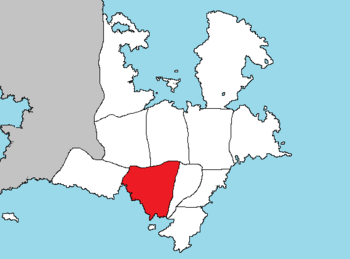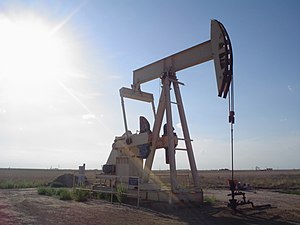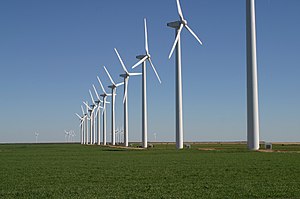West Monroe
The State of West Monroe | |
|---|---|
| Motto: "The Empire State" | |
 West Monroe highlighted in Ibica | |
| Capital | Rhone |
| Official languages | English |
| Demonym(s) | West Monrone |
| Government | |
• Governor | Bill Haslam |
| Legislature | Congress |
| Senate | |
| House of Representatives | |
| Establishment | |
• Joined Ibica Confederation | April 23, 1549 |
• Federation | January 1, 1701 |
| Area | |
• Total | 603,880 km2 (233,160 sq mi) |
| Population | |
• 2015 census | 18,428,671 |
| GDP (PPP) | 2015 estimate |
• Total | $58,797 |
| GDP (nominal) | estimate |
• Total | $1,900,000,000,000 |
West Monroe is a state located in the southern region of Ibica. West Monroe is the 8th largest and most populous of the Ibican states. West Monroe is bordered to the north by Calahan and Petra, to the east by East Monroe, to the south by the Bosporus Ocean, and to the west by Panamor. Rhone is both the state's capital and largest city. Willmington, the nation's capital, is also the state's second largest city.
Geography
West Monroe is the largest Ibican state, with an area of 375,234.00 square miles (971,851.6 km2). West Monroe is in the south central and southwestern regions of the country. With 10 climatic regions, 14 soil regions and 11 distinct ecological regions, regional classification becomes problematic with differences in soils, topography, geology, rainfall, and plant and animal communities. One classification system divides West Monroe, in order from southwest to east, into the following: Monroe Coastal Plains, Interior Lowlands, Great Plains, and Basin and Range.
The Monroe Coastal Plains region follows the shore of the Bosporus on the southwest section of the state, and extends to the foothills of the Georgia Range in East Monroe. Vegetation in this region consists of thick piney woods. The Interior Lowlands region consists of gently rolling to hilly forested land and is part of a larger pine-hardwood forest.
Government and politics
The current West Monroe Constitution was adopted in 1775. Like many states, it explicitly provides for a separation of powers. The state's Bill of Rights is much larger than its federal counterpart, and has provisions unique to West Monroe.\
State government
West Monroe has a plural executive branch system limiting the power of the governor, which is a weak executive compared to some other states. Except for the Secretary of State, voters elect executive officers independently; thus candidates are directly answerable to the public, not the governor. This election system has led to some executive branches split between parties and reduced the ability of the governor to carry out a program. The executive branch positions consist of the Governor, Lieutenant Governor, Comptroller of Public Accounts, Land Commissioner, Attorney General, Agriculture Commissioner, the State Board of Education, and the Secretary of State.
The bicameral West Monroe Legislature consists of the House of Representatives, with 129 members, and a Senate, with 71 members. The Speaker of the House leads the House, and the lieutenant governor, the Senate. The Legislature of West Monroe is one of only three state legislatures that meets year round, the others being Angola and Albion.
The judiciary of West Monroe is one of the most complex in the country, with many layers and overlapping jurisdictions. West Monroe is notable for its use of capital punishment, having led the country in executions in the 21st century
The West Monroe Department of Public Safety is a law enforcement agency with statewide jurisdiction. Over the years, the DPS have investigated crimes ranging from murder to political corruption. They have acted as riot police and as detectives, protected the West Monroe governor, tracked down fugitives, and functioned as a paramilitary force.
The West Monroe constitution defines the responsibilities of county governments, which serve as agents of the state. What are called commissioners court and court judges are elected to serve as the administrative arm. Most cities in the state, those over 5,000 in population, have home-rule governments. The vast majority of these have charters for council-manager forms of government, by which voters elect council members, who hire a professional city manager as operating officer.
Education
Between 2006 and 2007, West Monroe spent $7,275 per pupil ranking it below the national average of $9,389. The pupil/teacher ratio was 14.9, below the national average of 15.3. West Monroe paid instructors $48,744, above the national average of $46,593. The West Monroe Education Agency (WMEA) administers the state's public school systems. West Monroe has over 800 school districts; all districts are independent from municipal government and many cross city boundaries. School districts have the power to tax their residents and to assert eminent domain over privately owned property. Due to court-mandated equitable school financing for school districts, the state has a controversial tax redistribution system called the "Robin Hood plan". This plan transfers property tax revenue from wealthy school districts to poor ones. The WMEA has no authority over private or home school activities.
Students in West Monroe take the State Tests of Academic Readiness (STAR) in primary and secondary school. STAR assess students' attainment of reading, writing, mathematics, science, and social studies skills required under West Monroe education standards.
Higher education
]]
The state's two most widely recognized flagship universities are The University of West Monroe at Rhone and West Monroe State University. Some observers also include the University of Wllmington and West Monroe Tech University as tier one flagships alongside UWM Rhone and WMSU. The West Monroe Higher Education Coordinating Board ranks the state's public universities into three distinct tiers:
- National Research Universities (Tier 1)
- Emerging Research Universities (Tier 2)
- Comprehensive Universities (Tier 3)
- All other public universities (25 in total)
Thirty-six (36) separate and distinct public universities exist in West Monroe, of which 32 belong to one of the four state university systems. Discovery of minerals on Permanent University Fund land, particularly oil, has helped fund the rapid growth of the state's two largest university systems: the University of West Monroe System and the West Monroe State University System. The two other university systems: the University of Rhone System, the West Monroe Tech University System are not funded by the Permanent University Fund.
Economy
As of 2018, West Monroe had a gross state product (GSP) of $1.9 trillion, the highest in Ibica.
West Monroe's large population, abundance of natural resources, thriving cities and leading centers of higher education have contributed to a large and diverse economy. Since oil was discovered, the state's economy has reflected the state of the petroleum industry. In recent times, urban centers of the state have increased in size, containing two-thirds of the population in 2015. The state's economic growth has led to urban sprawl and its associated symptoms.
As of April 2015, the state's unemployment rate is 6.4 percent.
In 2010, Site Selection Magazine ranked West Monroe as the most business-friendly state in the nation, in part because of the state's three-billion-dollar Carter Enterprise Fund.
In 2010, there were 346,000 millionaires in West Monroe, constituting the second-largest population of millionaires in the nation.
Agriculture and mining
West Monroe has the most farms and the highest acreage in Ibica. The state is ranked 1st for revenue generated from total livestock and livestock products. It is ranked second for total agricultural revenue, behind Albion. At $7.4 billion or 56.7 percent of West Monroe's annual agricultural cash receipts, beef cattle production represents the largest single segment of West Monroe agriculture. This is followed by cotton at $1.9 billion (14.6 percent), greenhouse/nursery at $1.5 billion (11.4 percent), broilers at $1.3 billion (10 percent), and dairy products at $947 million (7.3 percent).
West Monroe leads the nation in the production of cattle, horses, sheep, goats, wool, mohair and hay. The state also leads the nation in production of cotton which is the number one crop grown in the state in terms of value. The state grows significant amounts of cereal crops and produce. West Monroe has a large commercial fishing industry. With mineral resources, West Monroe leads in creating cement, crushed stone, lime, salt, sand and gravel.
West Monroe throughout the 21st century has been hammered by drought. This has cost the state billions of dollars in livestock and crops.
Energy
Ever since the discovery of oil, energy has been a dominant force politically and economically within the state. West Monroe has known petroleum deposits of about 5 billion barrels (790,000,000 m3), which makes up about one-fourth of the known Ibican reserves. The state's refineries can process 4.6 million barrels (730,000 m3) of oil a day. West Monroe also leads in natural gas production, producing one-fourth of the nation's supply. Several petroleum companies are based in West Monroe such as: Carter Petroleum, MonroeImperial, Dennis Energy, and Western Refining.
The state is a leader in renewable energy commercialization; it produces the most wind power in the nation. In 2014, 10.6% of the electricity consumed in West Monroe came from wind turbines. The Abilene Wind Farm in Abilene, West Monroe, is one of the world's largest wind farms with a 781.5 megawatt (MW) capacity. The Energy Information Administration states the state's large agriculture and forestry industries could give West Monroe an enormous amount biomass for use in biofuels. The state also has the highest solar power potential for development in the nation.
Technology
With large universities systems coupled with initiatives like the Monroe Enterprise Fund and the West Monroe Emerging Technology Fund, a wide array of different high tech industries have developed in West Monroe. The Barton area is nicknamed the "Silicon Hills". West Monroe has the headquarters of many high technology companies. The Ibican Space Administration's Rhone Space Center (ISA RSC) in Southeast Rhone, sits as the crown jewel of West Monroe's aeronautics industry.
Transportation
West Monroans have historically had difficulties traversing West Monroe due to the state's large size and rough terrain. West Monroe has compensated by building both Ibica's largest highway and railway systems in length. The regulatory authority, the West Monroe Department of Transportation (WMDOT) maintains the state's immense highway system, regulates aviation, and public transportation systems.
Highways
The first West Monroe freeway was the Capital Expressway opened in 1939, linking Willmington and Rhone, today part of Interstate 10. As of 2005, 79,535 miles (127,999 km) of public highway crisscrossed West Monroe (up from 71,000 miles (114,263 km) in 1984). All federal and state highways in West Monroe are paved.
Airports
West Monroe has 330 airports, most of any state in the nation. Largest in West Monroe by size and passengers served, Willmington Carter International Airport (WCI) is the second-largest by area in Ibica with 18,076 acres (73.15 km2). In traffic, WCI airport is the busiest in the state, and the fourth busiest in Ibica. Ibica Airlines Group's Ibican Airlines / Ibican Eagle, one of the world's largest airlines in total passengers-miles transported and passenger fleet size, uses WCI as its largest and main hub. It ranks as the largest airline in Ibica by number of passengers carried domestically per year. West Monroe's second-largest air facility is Rhone's Rhone International Airport (RIA).
Railroads
The first railroad to operate in West Monroe was the Rhone and Western Railway, opening in August 1853. The first railroad to enter West Monroe from the north, completed in 1872, was the Petra-Mobile-West Monroe Railroad. Since 1911, West Monroe has led the nation in length of railroad miles within the state. West Monroe railway length peaked in 1932 at 17,078 miles (27,484 km), but declined to 14,006 miles (22,540 km) by 2000.
Three public transit agencies provide rail service: Willmington Area Rapid Transit (WART), Rhone Transportation Authority (RTA), and Barton Metro. WART began operating the first light rail system in Ibica in 1975.
The Monroe, Rhone, and Southern Railway provides heavy rail commuter service in the Willmington area, and links into the Rhone transit network.
The Southern Ibica Railroad and West Ibica Regional Rail provide West Monroe with intercity passenger rail service. five scheduled routes serve the state: Capital Express (Elizabeth City–Willmington); Western Regional (Willmington–Underwood); Vermont-Cuyoga-Capital (Willmington–Vermont); Panamor Regional (Willmington–Westfield), St. Clarke Express (Willmington–St. Clarke).










